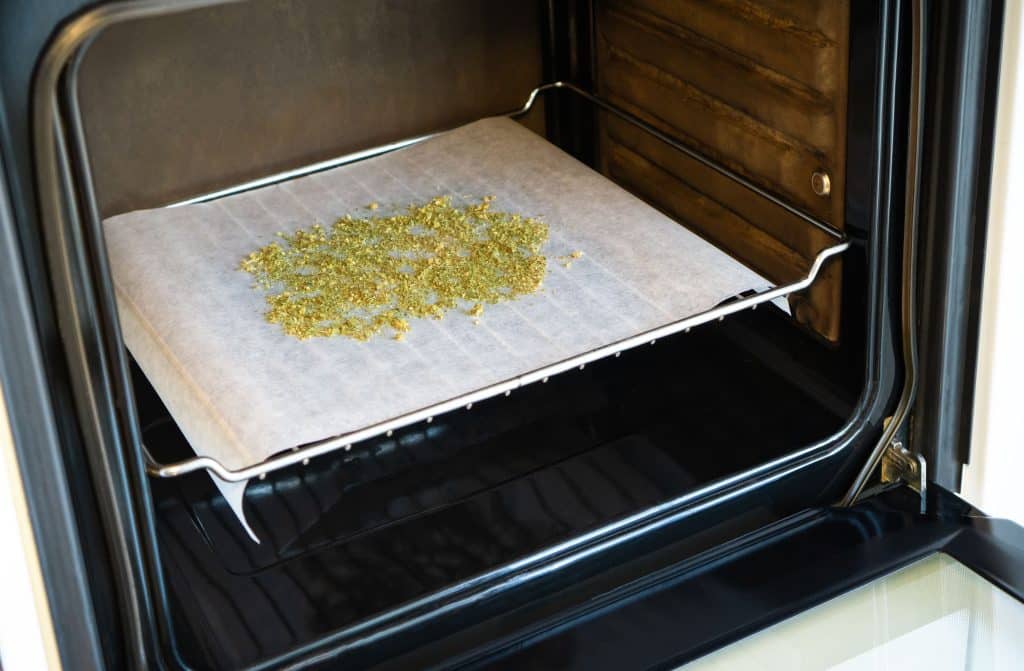We don’t just smoke weed these days, we vape it, swallow it in pills, inhale it through our noses, stick patches of it on our skin, and put it under our tongues as oil too. That last one is easy for anyone to do, whether you’ve got a dispensary around you, or not. At-home products are the new thing, so here are some DIY instructions for infused cannabis oil you can make in your very own home.
Looking for some DIY infused cannabis oil information? Well, you’re in the right place! This news platform is dedicated to reporting on cannabis and psychedelics topics across the spectrum. Don’t miss anything by subscribing to the THC Weekly Newsletter, which comes full of deals on products likes vapes, edibles, and cannabinoid compounds including HHC-O, Delta 8, Delta 9 THC, Delta-10 THC, THCO, THCV, THCP & HHC. If you’re going to buy your products, do your research, and make sure to only purchase products you’re happy with using.
What is an infused oil?
An infused oil is an oil made using some kind of a plant, which traps the plant’s constituents to create a concentrated oil. Infused oils can be made from most any plant, though not every plant is preferable for this. Oils are often better than the regular plant because they’re more concentrated, and can be used on a wider basis. They can go directly on the skin, be put in drinks or foods, or used to make drinks and foods.
The idea of an infused oil is to get all important components of a plant to leach out from the plant into the oil. Obviously, you can’t just squeeze a plant for what’s inside, and the process of making an infused oil can take a few hours. For some plants, since infusions are common, there are specific instructions all over the internet. For other plants which are less well-known, how to make them requires a bit more digging, or simply using standard recipes.
Luckily, in our case, infused cannabis oil is a popular item. This wasn’t the case several years ago, but the recent weed boom led to an increase in both the number and variation of products on shelves, as well as to more people making products at home. Growing plants was always a thing (though a much bigger thing now), but these days, its become more common for the everyday person to get involved in making their own DIY weed products.

An infused oil should not be confused with a tincture, though they are similar. A tincture is an extraction that uses alcohol (generally), but which is also made with glycerin or vinegar. In both tincture making and infused oil making, the goal is to leach the plant compounds into the chosen liquid. Tinctures enjoy a longer shelf life since they use alcohol, but take significantly longer to make. Infused oils don’t last as long, but with the right storage can sometimes stay good for as long as 1.5 years. Infused oils should also not be confused with essential oils, which come directly from the plant, and don’t require infusion.
People make infused cannabis oil for different purposes, and the oil you use as your base oil often dictates the purpose of the oil. For example, some people specifically want to make an oil for cooking, whereas others specifically want something good for their skin. Frequent oils used are coconut oil, avocado oil, sesame oil, and olive oil. Any edible oil is okay for an infused oil.
DIY infused cannabis oil instructions
Obviously when making a cooking oil, you’ll want to consider what you’ll be cooking, and the oil you specifically want to use for that. Oils have their own flavors, and when cooking, this must be considered. Oils like sesame oil and peanut oil, for example, have strong flavors that will most certainly come through, whereas canola is more neutral. This is not as important when not considering eating it later. For skin applications, the kind of oil matters less, although coconut oil is most popular for this purpose.
To make it from scratch, you’ll need the following materials: baking sheet of some kind, parchment paper or tin foil, oven, saucepan, mesh strainer or cheesecloth, and a separate oil container. You’ll also need 1 cup of cooking oil (whatever works best for you), and 7-10 grams cannabis (about 1 cup). These materials include what’s needed to decarb your weed. And that’s the first step.
- Decarb your weed. Without doing this, you’ll have THCA in your final product, which is not psychoactive. In order to get that THC high, you’ll need to heat the weed first. If you’re looking for a medicinal oil, then no decarb is necessary, and you can skip to the next step. Decarb instructions vary, though generally its done in the range of 200-300º F (93.3-149º C). Some like a longer decarb at the lower limit (45 minutes-1 hour), some like a shorter one at the higher limit (15-20) . Some go as high as 325º F (162º C) and only decarb for about 5 minutes. However you do it, you’ll grind your weed to just above powder, and spread it evenly on a baking sheet which gets put in the oven. Some cover the weed with parchment paper or tin foil, but this is up to you.
- Once its decarbed, you can fully grind it, and put it in a saucepan (can also be slow cooker or double-boiler) along with your cooking oil of choice. Simmer on low heat for 2-3 hours. The temperature should stay within this range: 160-200ºF (71-93ºC). Some publications say it can go as high as 245°F (118°C). When using a slow cooker or crock pot, still keep on low, but let sit with occasional stirring for more like 4-6 hours. For a double boiler, you’ll need 6-8 hours.

- When done, strain the oil through the mesh strainer or cheesecloth. Try not to squeeze as this makes more chlorophyll come out which can affect taste. Put the oil in a container and you’re good to go for about two months, or longer with refrigeration. Note: It’s best to try the oil out before using it in food, to get an idea of how strong it is, and how to dose it properly. This is less relevant if no decarboxylation took place.
Alternate way to make DIY infused cannabis oil
The instructions above are a standard way to make an infused oil, and work with most any oil desirable. However, there is an alternate way to do it if you’re specifically using olive oil or coconut oil. This version doesn’t require prior decarboxylation, so if for whatever reason you don’t have an oven, this is the option for you. For this recipe, do the following:
- Put your raw cannabis into your olive or coconut oil. Heat it in a saucepan until it reaches around 212-230°F (100-110°C), which works to decarboxylate the weed. In this case, you won’t have the option not to decarb it, so only use this method if you definitely want the THCA to turn to THC.
- Simmer and double boil for between 1-2 hours at 158-199°F (70-93°C). After the initial decarb, it shouldn’t go above 212°F (100°C) – which double boiling can help insure. Double boiling involves letting the mixture sit for 1-5 hours at 100-120°F (38-49°C). To keep from having to stain later when doing this method, the weed can be placed in cheesecloth during the process, so the particles don’t mix directly with the oil, and only the plant constituents come through the cheesecloth.
- When you’re done, strain if you must, or just remove your cheesecloth with cooked weed. All other instructions remain the same as the standard method. Though this methods works fine, it should be noted that the standard method of decarbing first is generally thought to be the more efficient method. This alternate way may not decarb cannabis as completely.
A few things to remember with DIY infused cannabis oil
Be aware of shelf life. Oils can naturally last a couple months on their own, but you can extend the shelf life. First off, make sure to properly strain in the beginning, as this keeps out unnecessary plant material, which can lead to a greater chance of mold or bacteria. Also, cannabinoids break down with heat and light, so keeping it in a cool and dark place (like a refrigerator) can extend the life to sometimes as long as 1.5 years. Even without a refrigerator, try to make sure the room its in is less than 70°F (21°C).

There are always a ton of recipes for anything in life, and though there are standard practices, sometimes there are variations that are good for certain circumstances. If you’re looking to make an infused oil, check several sources to get the best recipe for what you’re doing. For example, this recipe for infused olive oil specifically calls for distilled water, and a slightly different process. These instructions involve a bit more, but might be beneficial for some oil-makers.
And last, be careful with dosing. Each recipe tells you how to make the oil, but not necessarily how to use it after. The recipes also can’t account for issues that come up in your process, or the quality of cannabis you use. DIY infused cannabis oil can turn out in a lot of different ways, so before adding it to food and serving it to guests, (or slathering it all over your body), make sure you know your own product. Test it out, see how it works, and get a feel for how to dose it. It’s easy to go overboard with edibles and topicals, and being careful here is often the difference between a great time, and a really-not-so-great one.
Conclusion
It’s great that so many locations now have dispensaries where a person can go and buy a pre-made oil. However, for those who do not, or who prefer to make their own product, DIY cannabis infused oil is pretty easy to make, can be made in bulk amounts, and doesn’t require more than a few hours. Interested DIYers should also check out these instructions for cannabis tea, tinctures, hash, and even CBN.
Thanks for stopping by! We appreciate you joining us at Cannadelics.com (formerly known as CBDtesters.co), a top internet offering for comprehensive and independent news covering the cannabis and psychedelics spaces. Check out the site regularly for daily updates, and subscribe to The Cannadelics Weekly Newsletter, so you’re always on top of what’s going on.









